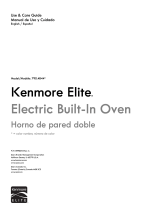
5
IMPORTANTINSTRUCTIONS
FORUSINGYOUROVEN
• UseCareWhenOpeningDoororDrawer—Stand
to the side of the appliance when opening the door
of a hot oven. Let hot air or steam escape before
you remove or replace food in the upper or lower
oven.
• KeepOvenVentDuctsUnobstructed.The oven
is vented at the front above the oven door or through
the rear of cooktop. Touching the surfaces in this
area when the oven is operating may cause severe
burns. Also, do not place plastic or heat-sensitive
items on or near the oven vent. These items could
melt or ignite.
• Placement of Upper or Lower Oven Racks.
Always place oven racks in desired location while
ovens are cool. Remove all utensils from the rack
before removing rack. If rack must be moved while
oven is hot, use extreme caution. Use potholders
and grasp the rack with both hands to reposition.
Donotletpotholderscontactthehotovenelement
or interior of the upper or lower oven.
• Donotuseabroilerpanwithoutitsinsert.The
broiler pan and grid allow dripping fat to drain and
be kept away from the high heat of the broiler.
• Do not cover your broiler or warmer drawer (if
equipped) grid with aluminum foil. Exposed fat
and grease could ignite.
• Donottouchahotlightbulbwithadampcloth.
Doingsocouldcausethebulbtobreak.Disconnect
the appliance or turn off the power to the appliance
before removing and replacing light bulb.
• Donotcookfoodontheovenbottom.Always
cook in proper bakeware and always use the
oven racks.
IMPORTANTINSTRUCTIONS
FORCLEANINGYOURRANGE
• Cleantherangeregularlytokeepallpartsfree
of grease that could catch re. Exhaust fan
ventilationhoodsandgreaseltersshouldbekept
clean.Donotallowgreasetoaccumulate.Greasy
depositsinthefancouldcatchre.Refertothe
hood manufacturer’s instructions for cleaning.
• Cleaners/aerosols—Always follow the
manufacturer’s recommended directions for use.
Beawarethatexcessresiduefromcleanersand
aerosolsmayignitecausingdamageand/orinjury.
Important Safety Instructions
Save these instructions for future reference.
bottoms large enough to cover the surface unit.
The use of undersized utensils will expose
a portion of the surface heating unit to direct
contact and may result in ignition of clothing.
Proper relationship of utensil to the surface unit
willalsoimproveefciency.
• Utensil Handles Should Be Turned Inward
andShouldNotExtendOverAdjacent
Surface Units—To reduce the risk of burns,
ignitionofammablematerials,andspillage
due to unintentional contact with the utensil.
The handle of the utensil should be positioned
so that it is turned inward, and does not extend
overadjacentsurfaceunit.
• Never Leave Surface Units Unattended—
Boiloverscausesmokingandgreasyspillovers
that may ignite, or a pan that has boiled dry may
melt.
• Protectiveliners—Donotusealuminum
foil to line oven bottom or any other part of
the appliance. Only use aluminum foil as
recommended for baking if used as a cover
placed on the food. Any other used of protective
liners or aluminum foil may result in a risk of
electricshockorreorashortcircuit.
• Glazed Cooking Utensils—Only certain types
of glass, glass/ceramic, ceramic, earthenware,
or other glazed utensils are suitable for cooktop
service without breaking due to the sudden
change in temperature. Check the manufacturer’s
recommendations for cooktop use.
• DoNotUseDecorativeSurfaceElement
Covers— If an element is accidentally turned
on, the decorative cover will become hot and
possiblymelt.Burnswilloccurifthehotcovers
aretouched.Damagemayalsobedonetothe
cooktop.
• Whenamingfoodsunderaventilatinghood,
turn on the fan.
• DoNotCleanorOperateaBrokenCooktop
—If cooktop should break, cleaning solutions
and spillovers may penetrate the broken
cooktop and create a risk of electric shock.
Contactaqualiedtechnicianimmediately.
• CleanCooktopGlasswithCaution—If a wet
sponge or cloth is used to wipe spills on a hot
cooking area, be careful to avoid a steam burn.
Some cleaners can produce harmful fumes if
applied to a hot surface.
• Avoidscratchingthecooktopglasswith
sharp objects.




















